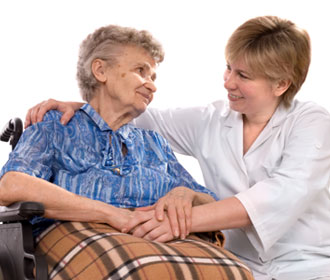
When a St. Luke’s hospice patient wanted to go to a Twins game with
her church group, her pastor was concerned that she would require too
much care over the course of the day. “One of our volunteers went
with her,” says Marilyn Fifield, volunteer coordinator for
St. Luke’s Hospice Duluth®. “They spent twelve hours together (not the usual!), and both had
a wonderful time.”
Volunteers play a key role at St. Luke’s Hospice Duluth, where home
care, inpatient care and bereavement follow-up are offered for terminally
ill patients and their families. The need for volunteers is greatest in
hospice home care.
“With hospice home care, there is someone to handle the medical,
but we need volunteers to help with other things, such as sitting with
the patient, brightening their day,” says Marilyn. “Many times
families don’t want to leave the bedside, but having a volunteer
there frees up the family for a break. Family can run out and get groceries,
work in their garden, do errands, meet with their book club, or meet with
their friends at the coffee shop. These are the things that are important
for helping the family members.”
Specialty volunteers
If you can cut hair, play music, sew or have some other talent, your services
are in high demand. “We currently have harp, flute, dulcimer, accordion
players and a guitarist/singer, but we never have enough music volunteers,”
says Marilyn. One volunteer sews cushion covers for wheelchairs to make
the seats more comfortable, and sometimes volunteers are needed to take
in clothing for patients who have lost weight.
“Just when I think I know all the ways a volunteer might be used,
the nurses will have a request and we find new ways,” says Marilyn.
Over the months, volunteers may develop wonderful relationships with patients
and families. “Sometimes, you get a series of patients who die in
a day or two and so you don’t get to make that connection,”
says Marilyn. “Short interactions, though, can be special and intense.
That’s why it’s so fulfilling. You are meeting new people
and new families all the time.”
Training and support
Hospice volunteers receive special training on the physical, psychosocial
and spiritual aspects of hospice care. “We start with a two-hour
interview, before training, to see what losses people have had in their
lives,” Marilyn says. “After the interview, if they want to
continue, they go through training and we evaluate again if they still
want to volunteer. It’s very personal for people. “
Volunteers are asked to give two to four hours a week and are assigned
to either hospice home care or the hospital inpatient setting based on
their interest. Current volunteers range in age from 18 to 80, and many
have been with a program for 10 to 15 years. Federal law requires that
at least 5% of the patient care hours in hospice be provided by volunteers.
“We have always met the 5% requirement and have been as high as
9% some months!” says Marilyn. "That’s another reason
we always need volunteers.
“Patients, families and staff appreciate the volunteers so much,”
says Marilyn. “Sometimes the patient is very ill and unable to communicate,
but then you have the families and they are incredibly grateful. Many
volunteers say they get back much more than they give.”
How to get started
Contact Marilyn at St. Luke’s Hospice Duluth for an application and
reading materials. Phone: 218.249.6105
mfifield@slhduluth.com. To learn more about hospice volunteering, visit the
Hospice Foundation website.